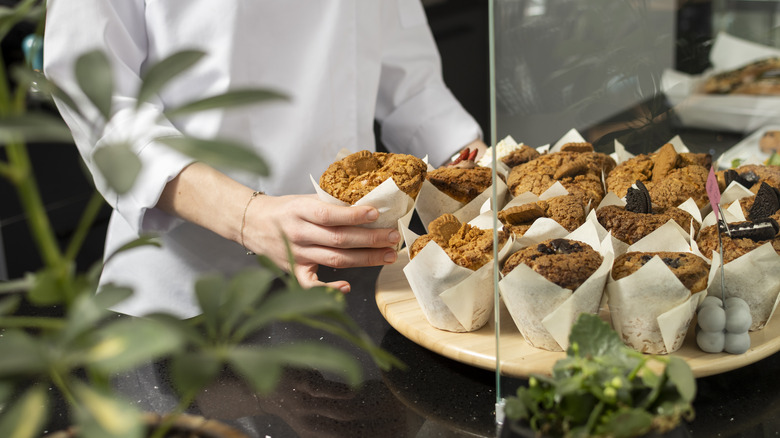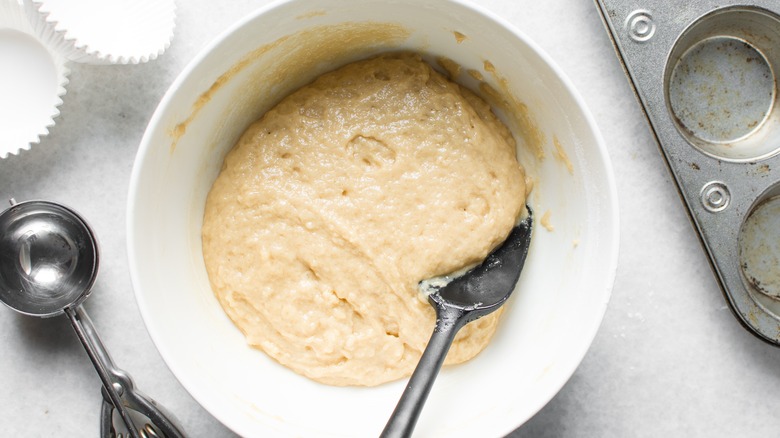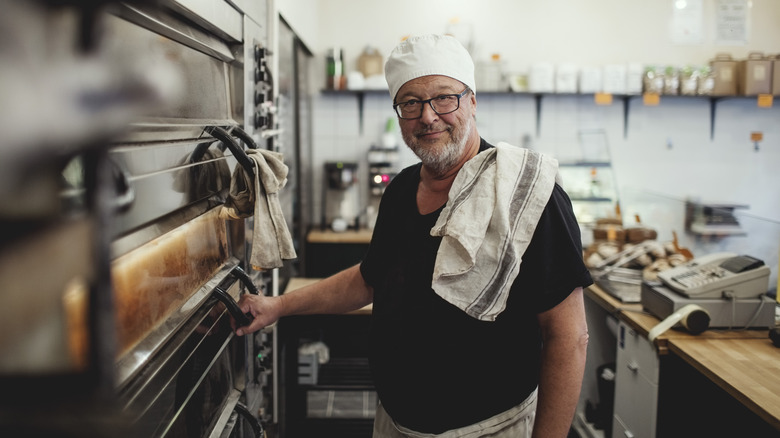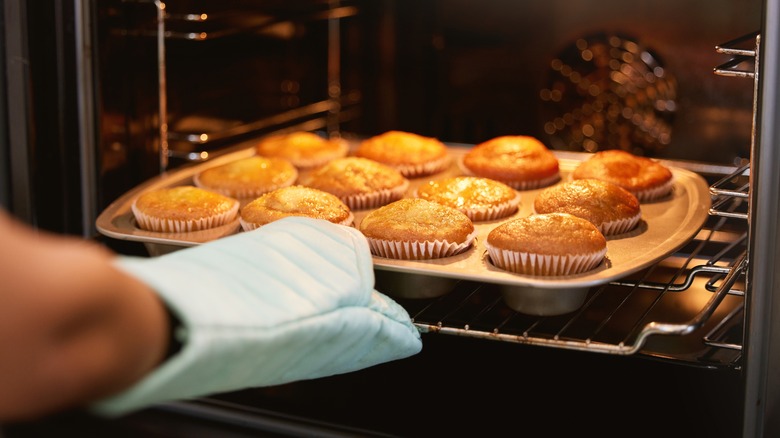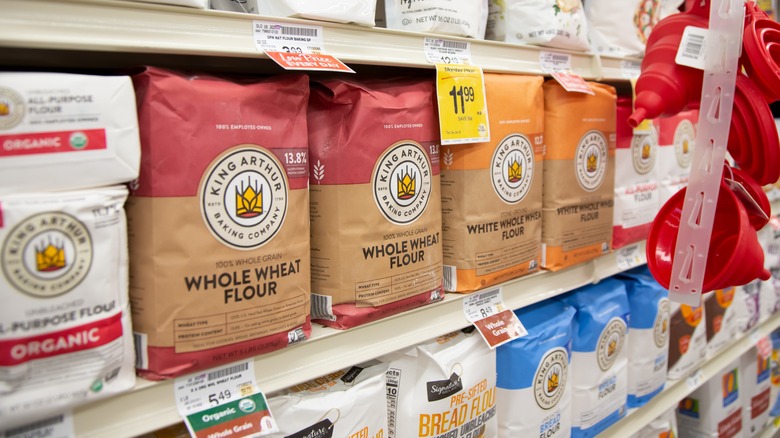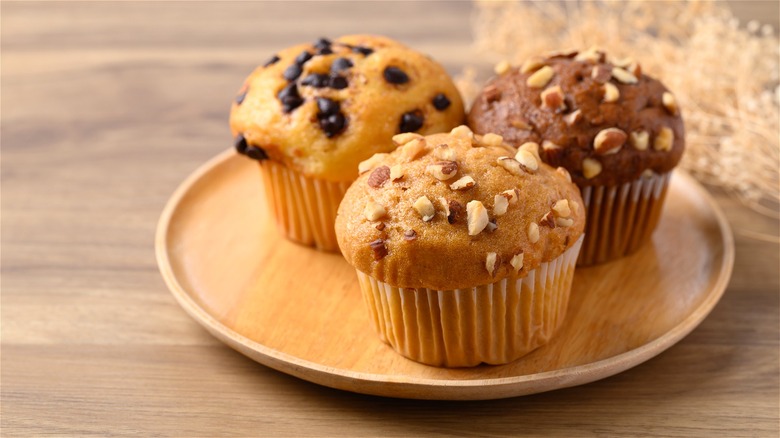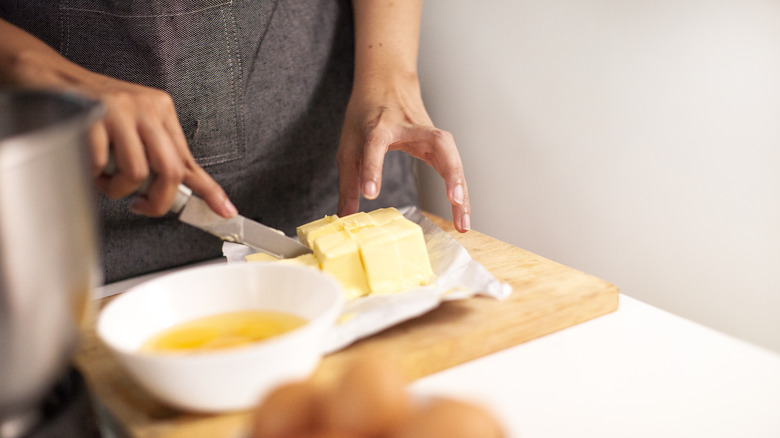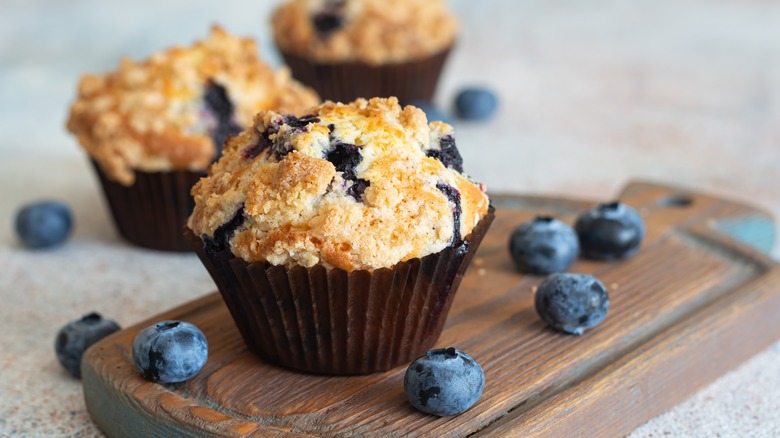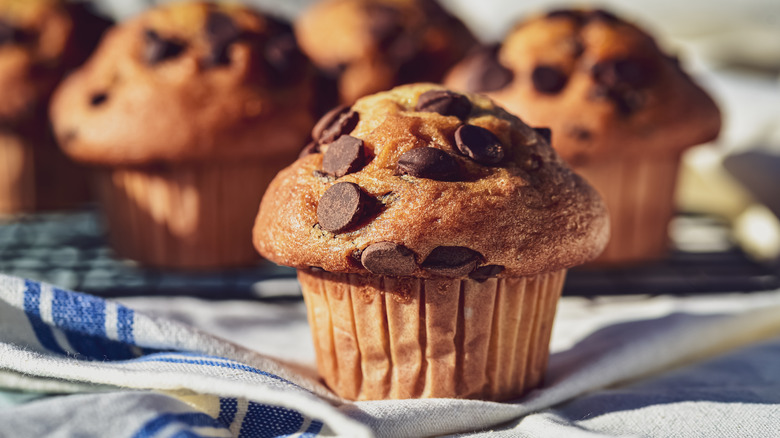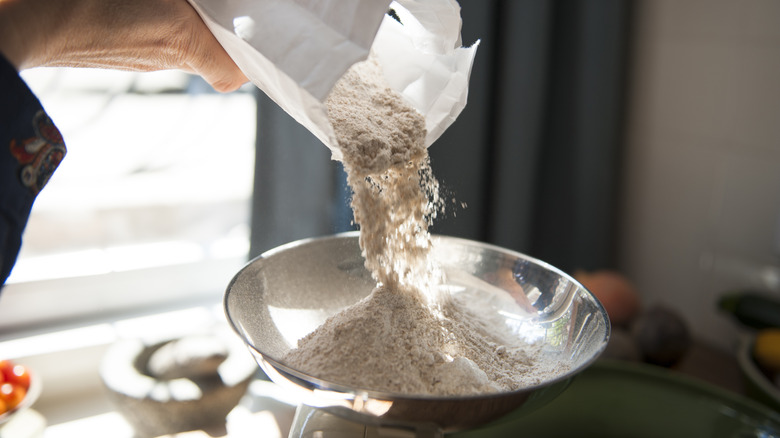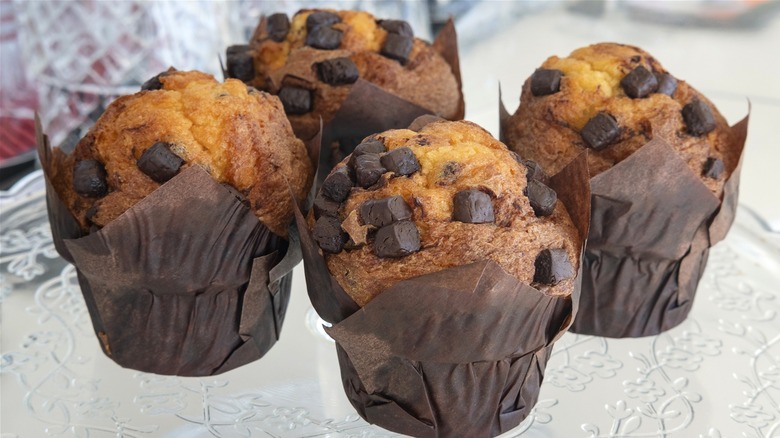Why Bakery Muffins Always Taste Better Than Those You Make At Home
In the United States, muffins have changed a lot over the years. Today, few baked goods are as versatile or prolific as them; thanks to their self-contained nature and the huge variety of flavors they come in, muffins are just as suited to being served as a rushed breakfast as they are a late-night snack. This isn't to say that everyone likes a muffin. In fact, they are incredibly divisive, with detractors bemoaning the dry texture and lackluster flavor presented by some muffins. In my opinion, the majority of these faults can be put down to bad baking practices that are often present in a domestic setting. As a former employee at several cafe-bakeries, I'm here to explain the practices that professional bakers use to ensure that their muffins are of excellent quality and always taste better than those made at home.
I learned how to make muffins while working at several cafe-bakeries located across both England and Scotland. At one of these locations, where I worked for just under a year, the first thing we did each and every day was make two batches of muffins: one sweet and the other savory. Over the months, I developed my skills until the muffins I made were large, domed treats that flew off the shelves. Luckily, achieving similar muffins at home is a pretty simple feat, as long as you heed the following pieces of advice.
Some bakeries rest muffin batter overnight
After starting my first job at a cafe-bakery, I quickly learned that one of the main advantages that those working at bakeries have over amateurs is that they know in advance what they will be baking and when they will be baking it. In my experience, I knew that the first thing I'd do every morning was bake muffins. This gave me, and the other employees, the ability to plan ahead, unlike most amateur bakers, who simply whip up a batch of muffins whenever they feel like it. Without a doubt, the most beneficial part of planning ahead is that it allows bakers to perform a step that improves the quality of muffins immeasurably: resting the batter overnight.
Resting the batter in the fridge overnight gives the starch time to absorb more moisture and subsequently swell up. Ultimately, this makes the muffins puff up during baking, producing a lighter, airer, and more visually striking finished product. The overnight resting period also allows any gluten that's been formed to relax, ensuring that the muffins boast a tender crumb.
If looking to utilize this tip at home, it's vital to check that your leavening agent is double-acting. This means it reacts twice: once when it's added to liquid and the second time when exposed to heat. If it isn't double-acting, your rested dough will fail to rise properly during baking.
Bakery ovens are more accurate
The vast majority of amateur bakers do not have access to expensive, high-specification ovens. Those working in bakeries, on the other hand, often do. During my time working in cafe-bakeries, I learned that, while access to a high-quality oven does not ensure excellent muffins will always be made, it definitely helps. This is for several reasons. The first of these is that high-specification ovens have very precise temperature control; thanks to superior insulation and accurate temperature gauges, once these ovens reach the listed temperature they tend to stay there. As a baker, this gave me the ability to accurately predict the muffins' baking times and thus avoid them from becoming over or under-baked.
Most conventional ovens have hotspots. While these hotspots can be identified using parchment paper, it is often impossible to avoid them. This can cause some muffins to bake quicker than others. The ovens used by professional bakers distribute heat evenly. This is vital when making batches of muffins, as it ensures that every muffin, regardless of where it is placed in the oven, cooks at the same rate as all the others.
As an added bonus, high-grade ovens heat up and cool down quicker than conventional ovens, allowing bakers to utilize a high-to-low temperature cooking technique. This, as we will soon see, is crucial to the production of high-quality muffins.
A high to low temperature technique is used during baking
It's common practice to cook muffins much like many other baked good; by placing them in an oven that is kept at a constant temperature. However, during my time making muffins professionally, I was told that this is actually not the best technique. Instead, muffins should be started off in a very hot oven (anywhere between 400 to 425 degrees Fahrenheit) for five minutes. The temperature should then be dropped to 350 degrees F for the remainder of the bake.
Initially placing the muffins in a high temperature environment improves their rise, resulting in the finished muffin boasting a lovely, domed top. There are several theories as to why this is. One is that the high temperatures mean the wet batter produces a lot of steam, which drives the batter upwards and fills it with air. Another is that the high temperatures cause the outside of the muffin to set, which forces the raw middle upwards as it cooks and expands.
It's important to note that anyone choosing to use this technique must ensure that they reduce the temperature after five minutes have elapsed. Fail to do so and the muffin will end up overcooked or, in the worst case, completely burnt.
Businesses have access to better quality ingredients
During my time in professional kitchens, I learned that every ingredient affects the quality of a finished dish. This is as true for muffins as it is for any other food, with ingredients like oil, flour, and chocolate chips having a profound influence on a muffin's texture, flavor, and consistency. Thanks to this knowledge, any bakery worth its salt makes an effort to source high-quality ingredients. In contrast, those baking at home often use whatever ingredients are on hand.
The impact quality ingredients can have on muffins is perhaps best exemplified by flour. While any all-purpose flour can be used to make muffins, bakeries often opt to source their flour from companies that test and regulate the protein content of their flour. As the protein content directly contributes to how much the muffins rise, and how tender or tough they are, buying high-quality flour that controls this variable is a must if the muffins are to be consistent from batch to batch, week to week.
Of course, the quality of ingredients also affects how the muffins taste. Take chocolate chips, for example. The cafe-bakery I worked at most recently made a point of ordering high-quality dark chocolate chips for the muffins. These pieces of chocolate added an impressively complex flavor, full of spice and fruity notes, that really brought the muffins alive. This was a stark contrast to the overly sweet chocolate chips present in so many mass-produced muffins.
Bakeries create bold flavor combinations
Everybody knows that muffins usually feature at least one flavoring. Muffins in this style, such as blueberry muffins and banana muffins, are classic options for a reason: They taste wonderful. However, customers have all seen and had them before. That's why, when I was working at the cafe-bakeries, we were encouraged to come up with new, innovative combinations with the goal of surprising our customers and taking our muffins to the next level. For those cooking at home, playing with contrasting flavors, such as sea salt and milk chocolate, and harmonious flavors, like caramel and banana, is a great way to start.
Whether contrasting or harmonious, flavor combinations should grab the consumer's attention. However, it's important to note that creating less expected flavor pairings is a tricky business. On more than one occasion, I dreamt up a combination I thought to be excellent, only to watch as one customer after another passed them by; a harsh reminder that all diners have a limit to just how adventurous they are willing to be.
Regardless of what flavorings you decide to add to your muffins, treating them with a little bit of care goes a long way. Fresh fruits, especially berries, should be gently mixed into the batter — lest they fall apart — while harder ingredients, like dried fruit or nuts, are best finely chopped to facilitate even distribution throughout the batter.
They use room temperature ingredients
A tip that will be familiar to just about every baker, whether their specialty is muffins or cakes, is to use room-temperature ingredients. Again, most people working at professional bakeries know what they are going to be baking and when, giving them ample opportunity to take ingredients out of the fridge and bring them up to temperature. Amateurs, who often bake on the fly, do not have this luxury.
As I understand it, using room-temperature ingredients is important, as it aids the emulsification process. Essentially, this means that the ingredients blend together more easily, resulting in a smooth and homogenous batter. While ensuring that the muffins don't contain any clumps of flour, a smooth batter also traps more air, meaning they enjoy a greater rise during baking and a lighter texture once done. What's more, the ease and speed with which the batter comes together helps prevent it from being over-mixed. This is hugely important as over-mixing crushes air bubbles that are present in the batter. Ultimately, this results in muffins that are dense, chewy, and tough.
Bakeries employ toppings, as well as fillings
During my time working in professional kitchens, I quickly learned that adding toppings to muffins was an easy way to improve their flavor, texture, and appearance. Take a sprinkling of sugar (an easy and popular muffin topping), for example. Not only does the sugar add a degree of sweetness to the muffin, it also provides textural contrast, as the crisp sugar gives way to a tender, soft crumb. Finally, it also looks wonderful, helping the muffins to stand out. Those working at professional bakeries know this and many swear by adding a topping to their muffins, even ones as simple as planting a banana chip into the top.
The number of potential toppings is practically endless. Chopped nuts, dried fruit, and even zest or finely diced herbs can be used to top a variety of muffins, both sweet and savory. Of course, you don't have to stick with solids; I am particularly fond of brushing sugar glazes, both flavored and plain, over the top of my muffins. Again, these add extra flavor to the muffins, while also giving them a beautiful, glossy shine.
The muffins are equally portioned
When I first started working in kitchens, I always used to wing it when portioning batter. Using just a regular spoon, I'd slop batter into the molds until they seemed about even with the others. The finished muffins, as you might expect, were far from a consistent size. This made it tricky for the front-of-house staff, as customers who'd seen others walk away with a gigantic muffin were more than a little disappointed when they were given one that was only two-thirds the size. Thankfully, this habit was soon drilled out of me. I am now a stickler for measuring out my portions.
The gold standard is and always will be to weigh each portion. This is the only way you can ensure that each mold holds exactly the same amount of batter as the one before it. However, I understand that this process is both tedious and time-consuming and that those baking for pleasure don't want to put themselves through it. With that in mind, I would recommend that home bakers use a measuring spoon to measure the batter by volume and subsequently distribute it. If the spoon is leveled off and no spillage occurs, the difference between the size of the resulting muffins will be negligible.
At bakeries, ingredients are measured by weight
As a British person with a Canadian parent, I am more attuned than most to the differences between measuring by volume and measuring by weight. While I use both when cooking other types of dishes, when baking I always use a scale and measure by weight. I would recommend that you do the same, as measuring by weight is both more accurate and more consistent, especially when it comes to dry ingredients.
Take, for example, a cup of flour. If it is loosely packed, a cup of flour can amount to 120 grams. If it is densely packed, the same measurement can weigh 160 grams. This is an enormous difference that could see one batch of muffins being very unlike the next. When weighed, however, 120 grams of flour is always 120 grams of flour. As such, measuring by weight removes this variance and ensures that the muffin batter is consistent from one batch to the next. It's for this reason that just about all professional bakeries measure by weight whenever they bake muffins or anything else for that matter.
Muffins made at the bakery are often bigger
When it comes to muffins, bigger is definitely better. At least, this was the opinion at every cafe-bakery I worked at. As a result, I was taught to completely fill muffin tray molds with batter instead of filling them two-thirds full, as most amateur bakers do. Filling the molds to the top not only results in a bigger muffin overall, but also ensures that the muffins develop a large, domed top. This makes them very appealing to look at. Aside from improving their appearance, larger muffins are also more forgiving to bake, as it takes longer to overcook them. This means that even inexperienced bakers are just about guaranteed to bake a muffin with a moist interior and tender crumb.
When making muffins in this manner, it is important to only use every other mold. This gives the muffins extra space to expand as they bake. Fail to do this and the muffins will end up crowding one another, stunting their growth and disfiguring their rounded shape.
